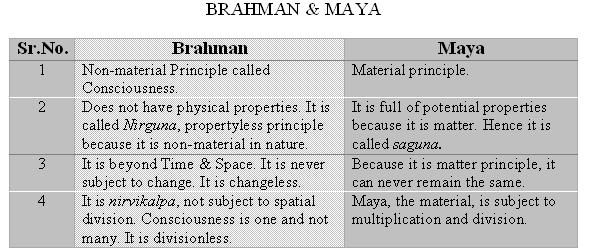TWO KINDS OF NATURE OF THE LORD
bhoomiraaponalo vaayuh kham mano buddhireva cha
ahamkaara iteeyam me bhinnaa prakritirashtadhaa // 7.4 //
Earth, water, fire, air, ether, mind, reason and ego - such is the eightfold division of My nature.
apareyamitastwanyaam prakritim viddhi me paraam
jeevabhootaam mahaabaaho yayedam dhaaryate jagat // 7.5 //
O Mighty Armed, this is my lower nature. But different from it, you know My higher nature, the indwelling spirit by which the universe is sustained.
The relationship between spirit and matter which is the source of creation is explained here. The Vedantic technical terms for these words are `Purusha' for the indwelling spirit and `Prakriti' for the matter. Matter is inert, insentient while spirit is sentient, dynamic. A combination of these two ingredients causes things to be born and function. In a steam engine, steam is the spirit-factor which makes the iron and steel assemblage of the engine which are matter-envelopments to function. The iron and steel components which are manufactured by somebody cannot function by themselves unless steam is made to pass through them. When the steam passes through the iron and steel assemblage we say that a steam engine is born or created.
CREATION
Let us understand the process of creation from the Vedantic angle in more details.
“First before understanding the topic of creation, we should clearly know that the very word creation is a misnomer because nothing can be created on account of the law of conservation of matter and energy. Then if at all we use the word Creation, it only refers to the manifestation of something which was potentially, un-manifestly existent. So only that which is un-manifestly, potentially existent in dormant form can come to manifestation.
MANIFEST VS UNMANIFEST
What is meant by the words manifest and unmanifest? By the word unmanifest, we mean Pramanam Agocharam. Unmanifest is that which is existent but is not available for perception or transaction like the butter in the milk. Butter is there in the milk, but we cannot see it in the milk. But we know that milk has butter. So what can we say about butter being existent or not? It is existent technically but for all practical purposes, since it is neither available for perception nor available for transaction we assume that butter is non-existent. But we know butter is there.
We can extend this analogy to everything in the creation. Nothing in the creation is non existent. It was existent in potential manner. Later it becomes manifest, which means it is available for transaction. Our scriptures point out, before the origination of this cosmos, it should have existed because of this simple law of conservation. And if this creation existed before, it should have existed in un-differentiated and unmanifest form or potential form or dormant form which we can call as the seed of the creation. In Sanskrit we use the word Bījam for this or Causal form of matter.
Matter in its causal form is the source of all forms of energy and all forms of matter. The causal matter is called Maya. This means that before the creation originated, one thing was there which is called Maya.
We have to include one more thing that existed before creation. That is Atma which is the consciousness principle, the non-material spirit. It does not come under matter and therefore it does not come within time and space. This means that as consciousness is beyond time and space it has to be eternal which implies that before the creation, consciousness also existed.
So now we had arrived at two things that were existing before creation -
•Principle 1: Consciousness which is called Atma which is unconditioned, un-influenced, un-circumscribed by the time and space.
•Principle 2: Whole creation in causal matter form called Maya
To put it in simple words, we can now conclude that Consciousness and Maya existed in causal form before creation.
In the context of cosmology or creation, consciousness is given another name. At the Micro level i.e., with reference to an individual, consciousness is given the name of Atma. The very same consciousness at the Macro level is called Brahman. Therefore Atma and Brahman are synonymous meaning the same thing i.e., consciousness.
Atma means Apnoti Sarvam Iti Atma – the boundless all pervading one. The word Brahman means infinite derived from the root Bruh – to be big – therefore Brahman means the Big One, the Absolutely Big One.
Thus the study of cosmology begins with two beginning-less principles known as
Brahman and Maya or Consciousness (Spirit) + Matter.
DIFFERENCE BETWEEN MAYA AND BRAHMAN
The common features of Brahman and Maya are both have no beginning, no origin. But differences are several as given in the Table below.

These are the basic similarities and differences between Brahman and Maya and out of their blending alone this universe comes into manifestation for our recognition like we churn and bring out the butter which is then available tangibly for our transaction.